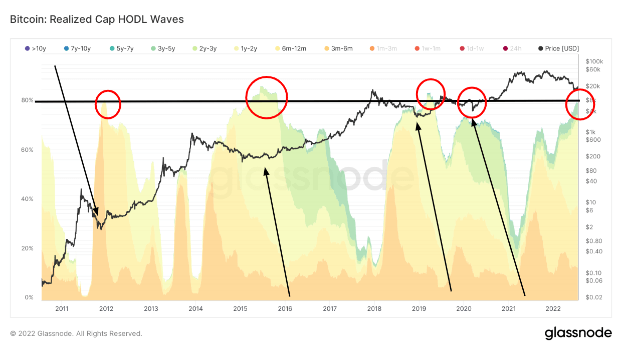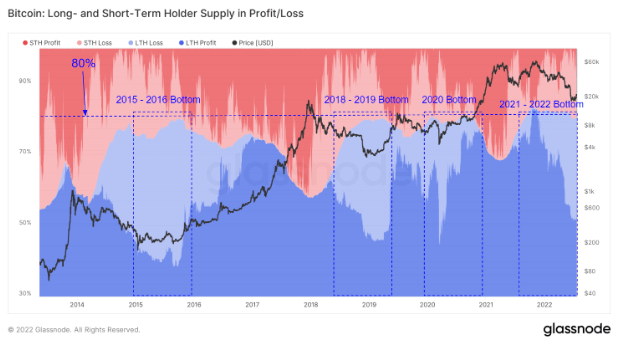Long-term owners own 80% of all Bitcoins
Numerous metrics can be used to determine cycle tops and bottoms, but realized cap HOLD waves are rarely mentioned in the group.
Also referred to as HODL waves, the metric represents the bundle of all active supply ages. In the chart below, each colored band shows the percentage of all circulating Bitcoin that was last moved within a certain time frame, weighted by its realized price.

Data from Glassnode has shown that 80% of Bitcoin’s circulating supply is in the hands of long-term holders (LTH). Defined as users who have owned Bitcoin for at least six months, LTHs are typically those that form strong support for Bitcoin’s market cycle bottoms.
LTHs are considered to be “smart money” in Bitcoin markets and are usually seen accumulating Bitcoin during suppressed markets. When a bull market sets in, LTHs are the ones who distribute the accumulated Bitcoin and take most of the profits.
On-chain data strongly supports this theory. The chart above clearly shows that every time Bitcoin claimed a new all-time high (ATH), LTHs sold off their holdings. During every cycle bottom, LTHs are the last resort, giving Bitcoin strong support.
Glassnode’s analysis of long- and short-term holder supply in profit and loss further substantiates this claim.
The chart below shows that 80% of Bitcoin’s supply is in the hands of LTHs, which are marked in blue. The remaining 20% of the supply is held by short-term holders (STHs) and is marked red. Overlaying the blue and red zones in the chart with Bitcoin’s price movements shows that LTHs saw almost no capitulation this market cycle – their holdings fell from 82% to 80% of supply.
The 2% decline is significantly lower than what we have seen in previous cycles, showing that the market has posted lower highs. As these lower highs reinforce the strength of the network, LTHs seem to reinforce their belief in Bitcoin’s value. The bear market that started in May saw only a small percentage of Bitcoin’s supply move from LTHs to STHs, as LTHs saw it as an opportunity to either hoard or continue to accumulate Bitcoin.
While the ongoing bear market looks eerily similar to all previous market cycle bottoms, it’s still too early to tell if the industry is about to head in a more bullish direction. However, if Bitcoin has reached the bottom of this cycle, we can expect a recovery in the coming weeks.



